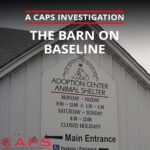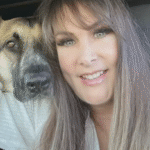Breeder: Watts, Cliff and Linda
Business name: Hillside Kennel
Address: 23784 Highway 303
City, State Zip: Hindsville, AR 72738
Year: 2004
USDA License: 71-A-0807
USDA Inspector: Jeffrey Baker, VMO
USDA Inspections: 2003-11-25
Date of CAPS Investigation: 2004-08-26
Approximately 300 dogs and 40 puppies. Breeds: Yorkshire Terriers, Chihuahuas, Cairn Terriers, Corgis
Kennel under construction
Cliff and Linda Watts’ property consisted of several kennels. One structure, under construction, had a flooring of small grey rocks, no walls, and wooden beams supporting a peaked metal roof. This kennel was about 120 feet long and 50 feet wide and housed 24 pens, 12 on each side, surrounded by five-foot-tall chain link walls. Four-foot-wide chain link doors provided entry to each pen.
Four of the pens each contained two adult Cairn Terriers, while the other pens each contained two adult Corgis. Each pen contained a single plastic dog house about two feet tall and wide and 2.5 feet long. Each pen also had a plastic food dish and a plastic water dish on their pen flooring. The water dishes were all filled with grayish-brown water (3.10-Watering), and none of the food dishes were placed so as to minimize contamination by excreta (3.9-Feeding).
Indoor/outdoor facility with whelping room
Another structure consisted of indoor and outdoor pens. The outdoor whelping section was accessible to the indoor structure by means of a covered walkway. The entryway led immediately to a whelping room, which had another exit in the direction of the building described in the above paragraph, as well as an exit which led to the structure’s main indoor kennel. The whelping room, about 10 feet wide and 30 feet long, had wooden walls. The remainder of the building had a metal roof with open insulation under it and blue tarps used as walls.
The four-by-six-foot pens of the outdoor facility had dirt floorings, five-foot-tall chain link walls, and three-foot-wide chain link doorways. Each pen had a plastic sheet along one of its walls that ran the length and height of the wall so that the dogs of each pen could not come into contact with each other.
Each pen contained an igloo-type dog house about two feet tall and 2.5 feet in diameter. Each pen also had plastic food and water dishes on the ground, and the food dishes were not placed so as to minimize contamination by excreta (3.9(b)-Feeding). Feces and urine covered the ground of each pen, (3.1(f)-Drainage and waste disposal) (3.11(a)-Cleaning of primary enclosures). The water dishes of all of the pens contained dingy, dark brown water (3.10-Watering).
One outdoor pen contained two adult Cairn Terriers. The pen next to it contained a nursing Cairn Terrier mother and several three to four week old Cairn Terrier puppies. This pen had a rubber sheet about a foot tall and four feet long along the bottom of its front wall. The puppies were walking through the feces piles on the pen flooring (3.11(a)-Cleaning of primary enclosures).
Another pen contained a nursing Corgi mother and three Corgi puppies, each about three to four weeks old. One of the puppies had pushed its head completely through one of the holes of the chain link wiring (3.6(a)(1)(iii)-Primary enclosures). Two other pens each contained two adult Keeshounds, and the last pen contained three adult Shih Tzus; one Shih Tzu had matted fur surrounding its nose and eyes (2.40-Vet Care). The small indoor whelping room had treated wire cages that were stacked two or three high. There were plastic sheets under the cages to catch debris. Some cages contained two adult small-breed dogs such as Chihuahuas, Schipperkes, and Yorkshire Terriers, while others contained a single nursing mother with several of her puppies. A single fan, set atop a cage, ventilated this room (3.3(b)-Ventilation). The room was cluttered with plastic food storage bins, food bags, medicine cabinets, and spare cages (3.1(b-Condition and site).
Main kennel
The main kennel was inside the same enclosure that had the whelping room. It was about a hundred feet long and thirty feet wide, with pens on both long sides and a dirt walkway in the middle. Each pen was about three feet wide and eight feet long, with four foot tall walls made with PVC piping around their corners and edges and galvanized wire in between. Each pen contained a red plastic self feeder attached to one of its walls and a plastic water dish on the pen flooring that contained dingy brown water (3.10-Watering).
The dirt pen floors were covered with wood chips. They were littered and stained with more than a day’s worth of feces and urine (3.1(c)(3)-Cleaning) (3.11(a)-Cleaning of primary enclosures). Some floors had one inch thick rubber sheets with one inch wide holes. The holes of the sheets were full of feces and urine-soaked wood chips (3.1(c)(3)-Cleaning) (3.11(a)-Cleaning of primary enclosures).
Many pens also had untreated wooden boards (3.2(d)-Interior surfaces) of varying sizes set at random against the bottoms of the pens’ side walls. Some were six inches to a foot tall and two to three feet long; others were up to three feet tall and only a foot long. The boards were attached to the wire walls with bungee cords, and some boards were partially laid over each other (3.1(a)-Structure; construction). The sharp edges of the boards were protruding into the pens (3.1(c)(1)(ii)-Surfaces).
Each pen contained four to six adult dogs. The breeds included Shih Tzus, Chihuahuas, Maltese, and Yorkshire Terriers. In the walkway between the pens, fans of various sizes (from one to three feet in diameter) had been set-up to blow into the pens.




